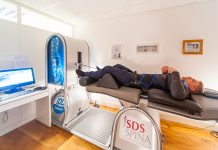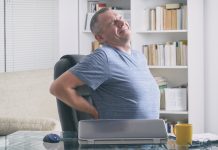Hamilton Hall MD FRCSC, Executive Director, Canadian Spine Society/Back Care Canada, helps us to understand back pain, leg pain and how to manage the problem
Do you know someone with a bad back? Have you had an attack of back pain? Chances are you answered yes to one and probably both questions. Back pain strikes over 80% of people living in industrial nations at some time in their life. For most, it is a short-term event that subsides completely, but for an unlucky few, it can become a chronic or recurring problem. Seeking medical attention for a sore back is one of the most frequent rationales for visiting a doctor. Back problems are a huge financial burden on our economy; they are the most common reason for recurrent time away from work.
Back pain is widespread but misunderstood
While back pain is a significant problem worldwide, it is also hugely misunderstood. No matter how much they hurt, nearly all episodes are caused by minor, self-limiting mechanical impairments. Less than three patients in a hundred have a sinister pathology such as spinal infection or systemic illness. Less than one patient in a hundred has spinal malignancy.
Rather than viewing it as a disease, think of it as a human experience, as natural to an ageing spine as wrinkles to ageing skin. One reason for the misapprehension is the amount of distress. The pain is protective and a signal that something is not right. But, like a small speck of grit in your eye, symptoms are out of proportion to the physical injury.
There is no cure for back pain
Another incentive to regard back pain as an unfortunate, temporary incident rather than a disease is because there is no cure. For over a century, physicians have medicalized and treated the discomfort but have been unable to prevent it.
Managing the complaint with medication, physical modalities, psychotherapy or surgery is a multibillion-dollar industry whose focus often suggests a disease to be cured rather than a natural condition to be managed. This leads to excessive imaging and superfluous investigations.
Modern technology has, in some instances, made things worse. The sensitivity of magnetic resonance images (MRI) is so great that it identifies insignificant abnormalities, which are then mistakenly labeled and treated as the site of the pain. The unfortunate ramifications of this misidentification mean that using the MRI as a screening tool without specific clinical suspicions has a strongly negative impact on patient outcomes.

Two-thirds of back pain attacks occur spontaneously
Another harmful misconception is patients’ belief that they must be responsible for the attack, that if only they hadn’t done something wrong, it never would have happened. This erroneous idea can lead to needless self-recrimination, unnecessary restrictions and avoidance of enjoyable future activities. In reality, two-thirds of back pain attacks occur spontaneously. They happen no matter what you do, whether you scrupulously bend your knees when you lift or sleep on a top-of-the-line mattress. However, the duration and intensity of the episodes can be diminished with good body mechanics and appropriate pain control maneuvers. The achievable goal is to control not cure.
Where to start when it comes to managing back pain?
A useful starting point in dealing with the affliction is establishing whether the pain is worse in the back or in the leg. Back dominant pain, which includes discomfort felt most intensely in the buttocks or flanks as well as along the spine, is referred from structures within the spinal column. The origin is usually one of the intervertebral discs – fibrous cushions that separate the boney vertebrae – or one of the small, interlocking joints that link the vertebra together.
Leg dominant pain – pain that is most severe in the thigh, calf, ankle or foot – is generated by directly irritating one of the nerves leaving the spine and traveling down the leg. But back-dominant pain usually spreads down the leg, and leg-dominant pain is typically accompanied by pain in the back. So, the question is not where do you hurt but where do you hurt the most? If you could stop only one pain, which would you choose: back or leg?
The overwhelming majority of sufferers experience back-dominant pain caused by nothing more serious than a dried-out disc or a worn small joint. Contradicting the popular assumption about the source of the problem, only that small minority of “back” pain suffers with leg dominant symptoms will have a pinched nerve.
Back dominant pain is generally mechanical; the pain can be altered by movement and changes in position, which affect the amount of pressure on the painful structure. Mechanical pain is best treated mechanically by finding postures or activities that reduce the symptoms. Unloading the spine by lying down can be helpful but only for short, regularly scheduled intervals. Prolonged rest weakens muscles and always makes things worse.
You must be the one who takes charge
So, stay active. Experiment to find the positions and movements that decrease your symptoms. Remember, hurt does not equal harm; you cannot damage your spine by trying new ways to control the pain. You may seek advice, but you must be the one who takes charge.
Medication has a secondary role. It helps as you adjust your routines to manage the discomfort, but it should never become the principal method of pain control. Avoid opioids. Narcotic medication is surprisingly ineffective in decreasing pain but significantly raises the risk of addiction.
Perhaps most importantly, eliminating the misinformation and fear surrounding this issue is key. No matter how intense and transiently disabling, almost all attacks are the result of minor mechanical issues, not incurable diseases or malignancies. Most back pain can be successfully managed through a combination of scheduled rest, activity modification, specific pain control manoeuvres, simple counterirritants like hot or cold packs, and over-the-counter medication and knowledge.
Contributor Details
Editor's Recommended Articles
-
Must Read >> CBD oil for pain: What the research shows
-
Must Read >> 13 remedies for back pain during pregnancy
















This was great, I have been researching for a while now, and I think this has helped. Have you ever come across Health Natural Centre Parkinson’s disease HERBAL FORMULA (just google it). It is a smashing one of a kind product for reversing Parkinson’s completely. Ive heard some decent things about it and my buddy got amazing success with it.